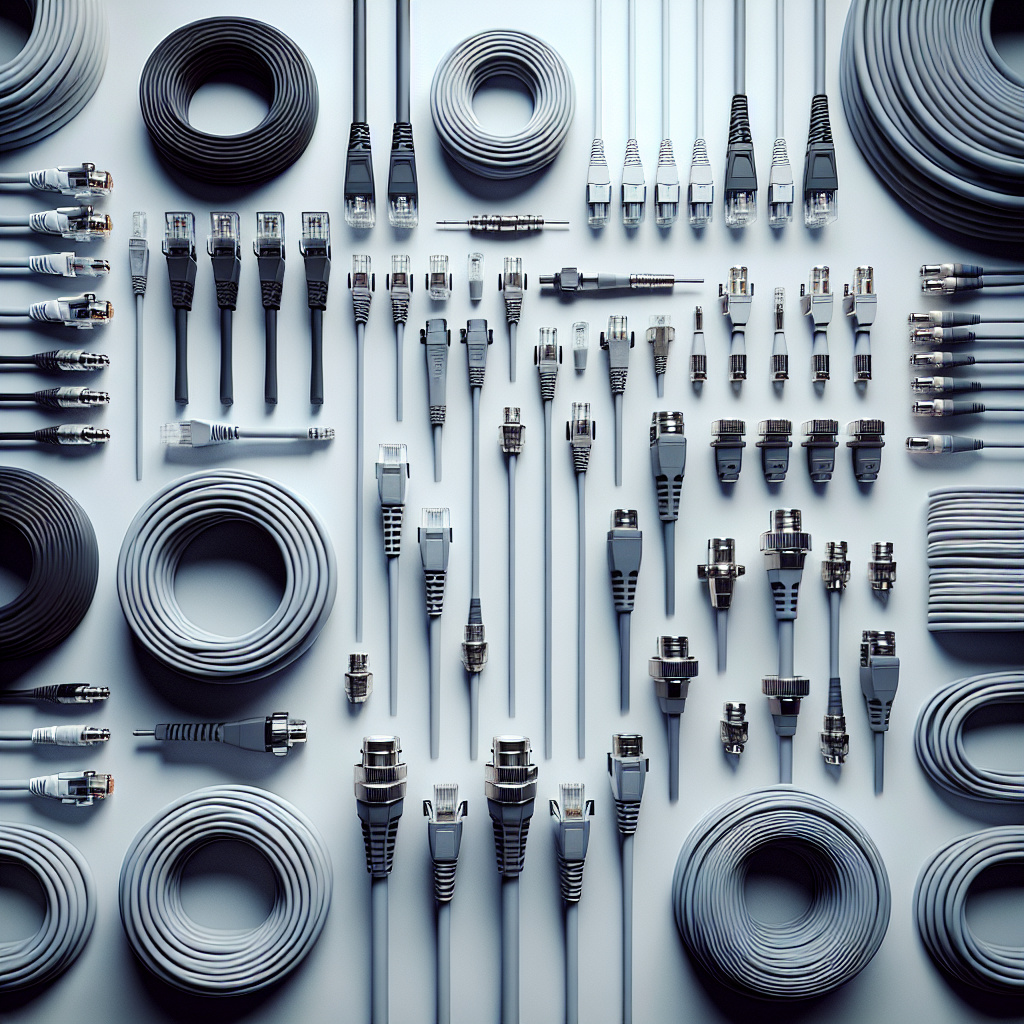Understanding the role of network cables is fundamental in the modern world where virtually every aspect of our daily activities relies on data transmission. Network cables are the unsung heroes that facilitate this connectivity, forming the backbone of any network infrastructure. In essence, they are used to connect and transfer data between computers, routers, switches, and storage area networks within a localized environment, or across larger distances.
There are various types of network cables, such as Ethernet cables, fiber optic cables, and coaxial cables, each serving specific needs based on data transfer speed, latency, and environmental factors. Ethernet cables, like the widely used Cat5e and Cat6, are perfect for setting up home and office networks, supporting high-speed internet and local network connections. Fiber optic cables, on the other hand, excel in long-distance data transmission with minimal loss, making them ideal for internet backbones and broadband connections.
What are network cables used for? They are pivotal in ensuring that we can share resources like printers and servers, access multimedia content, engage in online gaming, and maintain effective communication channels over VoIP services. Their correct installation and maintenance can significantly affect network performance and reliability.
Visit our website to learn more and get started today! Click here.
Different Types of Network Cables and Their Uses
Delving deeper into the world of connectivity, it’s important to distinguish between the different types of network cables, as each serves a unique purpose within a network infrastructure. The most common types include Twisted Pair cables (STP and UTP), Coaxial cables, and Fiber Optic cables. Twisted Pair cables are further divided into Shielded (STP) and Unshielded (UTP) categories, with UTP being the most prevalent in office and home environments due to its cost-effectiveness and ease of installation.
Coaxial cables, once the foundation of cable television and internet services, are known for their durability and shielding against electromagnetic interference. Although their use has diminished in favor of Twisted Pair and Fiber Optic cables, they still play a role in specific settings that require their robust characteristics.
When it comes to high-speed data transmission and long-distance communication, Fiber Optic cables are unmatched. They utilize light to transmit data, which allows for faster speeds and a greater resistance to interference compared to their metallic counterparts. These cables are integral in wide-area networks (WANs) and in situations where high bandwidth is essential.
Each type of network cable is optimized for a particular use case, factoring in the required bandwidth, distance, and environmental conditions. For instance, while an office may use Cat6 UTP cables for their local area network (LAN), a data center might require the advanced capabilities of Fiber Optic cables to handle the massive data traffic efficiently.
How Network Cables Power Our Daily Internet Usage
It’s easy to overlook the physical components that power our daily internet experiences, but network cables are the unsung heroes behind the scenes. They are the conduits that carry the data we rely on for everything from streaming our favorite shows to engaging in video conferences and powering our online transactions. Network cables serve as the critical infrastructure that connects various devices to the internet, local networks, and to each other.
Whether it’s a student attending a virtual class, a professional working from home, or a gamer enjoying an online multiplayer session, the stability and speed of these connections are largely dependent on the quality of the network cables used. These cables ensure that data packets travel efficiently from one point to another, minimizing latency and maximizing bandwidth, which are key factors for a seamless online experience.
In homes and businesses alike, network cables are often connected to routers, switches, and modems, forming a stable network that supports the demand for constant connectivity. As the number of connected devices continues to grow, with the advent of the Internet of Things (IoT), the role of network cables becomes even more pivotal. They must not only handle traditional data traffic but also the continuous exchange of information between smart devices.
Without the proper installation and maintenance of these cables, we could face interruptions and slowdowns that would disrupt our digital lives. Therefore, understanding what are network cables used for extends beyond mere connectivity; it’s about ensuring the reliability and efficiency of our daily internet usage.
Network Cable Installation Best Practices
Proper installation of network cables is vital to the performance and reliability of any network system. Adhering to best practices during installation not only maximizes network efficiency but also extends the lifetime of the infrastructure. Cable management is a critical aspect, ensuring that cables are neatly organized, which reduces the risk of damage and makes future maintenance or changes more manageable.
One key practice is to follow the color coding standards for different types of network cables, such as Ethernet. This facilitates easy identification and prevents confusion during troubleshooting or expansion. Additionally, avoiding sharp bends and following the bend radius specifications for the cable type is essential to prevent damage to the internal wiring, which can degrade signal quality.
Another important practice is testing every cable after installation. This step confirms that the cable is functioning correctly and that there are no faults which could impact network performance. It’s also crucial to adhere to building codes and standards, such as the ANSI/TIA/EIA standards, which provide guidelines on the maximum length of runs, separation from power cables, and other safety considerations.
Moreover, selecting the right cable for the environment is imperative. For instance, plenum-rated cables are designed for use in spaces where air circulates for heating and cooling systems, as they produce less toxic smoke in the event of a fire. On the other hand, riser-rated cables are used in vertical runs between floors.
Ultimately, proper network cable installation is not just about physical setup; it’s about creating a foundation that supports current and future technological needs. By following these best practices, businesses and residents can ensure a robust and scalable network infrastructure.
The Future of Wired Connectivity in an Increasingly Wireless World
While wireless technology continues to advance, offering convenience and mobility, wired connectivity remains an essential and evolving component of modern networks. Despite the proliferation of wireless devices, the demand for high-speed, secure, and reliable connections means that network cables are not going anywhere soon. Wired networks offer advantages in speed and stability that wireless technology struggles to match, especially in environments with high interference or when transferring large volumes of data.
The development of new cabling standards, such as Cat8 and beyond, is pushing the boundaries of wired connectivity’s capabilities. These advancements promise even higher data transfer rates, improved crosstalk prevention, and better overall performance. Moreover, wired networks are less susceptible to eavesdropping, making them a preferred choice for security-conscious businesses and industries with stringent data protection requirements.
Furthermore, the integration of Power over Ethernet (PoE) technology adds a new dimension to network cables’ functionality, allowing devices to receive both power and data over the same cable. This simplifies the installation of networked devices such as cameras, phones, and access points, and is expected to be a key driver in the continued importance of wired networks.
In industrial and commercial settings, the reliability and security offered by wired connections cannot be compromised. As the Internet of Things (IoT) expands, more devices require a stable network connection, often best served by wired infrastructure. In the future, we can expect a hybrid approach, with wireless technologies complementing a core of wired connections, ensuring robust, adaptable, and secure network infrastructure.
The discussion about the future of wired connectivity in an increasingly wireless world is not about replacement, but rather about the right balance and integration of technologies to serve evolving digital needs.
Choosing the Right Network Cable for Your Needs
Visit our website to learn more and get started today! Click here. Selecting the right network cable for your infrastructure is crucial to ensure optimal performance and reliability. The choice depends on several factors, including the required data transfer speed, network environment, and budget. Cat5e cables are suitable for most residential applications, providing speeds up to 1 Gbps. For commercial environments with higher data throughput, Cat6, Cat6a, or Cat7 cables might be more appropriate, offering speeds of 10 Gbps or more.
It is also important to consider the length of the cable needed for your setup. Signal degradation occurs over long distances, so for runs longer than 100 meters, additional network hardware like switches or repeaters is necessary. Moreover, the environment is a deciding factor; in areas with high electromagnetic interference, shielded twisted pair (STP) cables provide an extra layer of protection against signal disruption.
In specialized settings, such as data centers or industrial applications, the durability of the cabling is paramount. Look for cables with robust insulation and protective jackets that can withstand harsh conditions. Lastly, future-proofing your network by choosing cables that exceed current requirements can save you from premature upgrades as technology advances.
Making the right choice can be daunting, but with our expertise at Rapid Voice Data Solutions, we can guide you through the process, ensuring your business or residence is equipped with the best infrastructure wiring and equipment install. Get started today by visiting our website.





